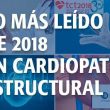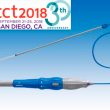The Fourth Universal Definition of Myocardial Infarction is a document developed jointly by the European Society of Cardiology (ESC), the American College of Cardiology (ACC), the American Heart Association (AHA), and the World Heart Federation (WHF). The Fourth Definition was necessary for multiple reasons, including increasingly higher troponin sensitivity. While troponin obviously does not<a href="https://solaci.org/en/2019/01/30/the-ten-commandments-for-the-fourth-universal-definition-of-infarction/" title="Read more" >...</a>
The Most Important Articles of 2018 in Structural Heart Diseases
1- ESC 2018 | MITRA FR: Testing MitraClip for Secondary Mitral Regurgitation In secondary mitral regurgitation, mitral-valve leaflets and chordae are structurally normal and mitral regurgitation results from alterations in left ventricular geometry and function. Read more 2- TCT 2018 | COAPT: MitraClip in Patients with Secondary Mitral Regurgitation The prognosis of patients with<a href="https://solaci.org/en/2019/01/18/the-most-important-articles-of-2018-in-structural-heart-diseases/" title="Read more" >...</a>
The 10 Most Read Articles of December
1- Everolimus-Eluting Stents Finally Have a Rival and Not Just a “Non-Inferior” Stent In this large randomized trial, there were significant differences as regards both target-lesion failure and target-vessel-related infarction, which persisted through a 2-year follow-up and favored treatment with an ultrathin-strut bioresorbable-polymer sirolimus-eluting stent (Orsiro) compared with the gold standard, a durable-polymer everolimus-eluting stent<a href="https://solaci.org/en/2019/01/04/the-10-most-read-articles-of-december/" title="Read more" >...</a>
Is TAVR at Hospitals Without Backup Cardiovascular Surgery Feasible?
Patients undergoing transcatheter aortic valve replacement (TAVR) at hospitals without cardiovascular surgery available are at significantly higher risk. That in itself is a call for attention; however, a propensity-matched analysis shows that the short- and long-term mortality rates are similar among patients treated at hospitals with and without cardiovascular surgery backup. This debate emerged a<a href="https://solaci.org/en/2018/12/03/is-tavr-at-hospitals-without-backup-cardiovascular-surgery-feasible/" title="Read more" >...</a>
TAVR in Low-Risk Patients with “Zero” Mortality and “Zero” Stroke
Transcatheter aortic valve replacement (TAVR) is now the standard of care for patients with symptomatic severe aortic stenosis who are at extreme, high, or intermediate risk for surgery. This multicenter, prospective study (Feasibility of Transcatheter Aortic Valve Replacement in Low-Risk Patients With Symptomatic, Severe Aortic Stenosis) included low-risk patients and was approved by the United<a href="https://solaci.org/en/2018/11/09/tavr-in-low-risk-patients-with-zero-mortality-and-zero-stroke/" title="Read more" >...</a>
Safety of Lesion Deferral with iFR or FFR in Both Stable and Acute Patients
Overall, deferral of lesion revascularization is equally safe with both fractional flow reserve (FFR) and instantaneous wave-free ratio (iFR), with a low rate of events of about 4%. Lesions were more frequently deferred when iFR (as opposed to FFR) was used for functional assessment. Among patients with deferred lesions, acute patients experienced significantly more events<a href="https://solaci.org/en/2018/10/19/safety-of-lesion-deferral-with-ifr-or-ffr-in-both-stable-and-acute-patients/" title="Read more" >...</a>
TCT 2018 | PREPARE-CALC: Rotational Atherectomy vs. Cutting Balloon in Calcified Lesions
Compared against conventional predilation with balloon, rotational atherectomy is associated with higher procedural success rate in severely classified lesions. Balloons capable of modifying plaque such as the Flextome Cutting Balloon or the AngioSculpt Scoring Balloon -among others- could reach similar results to that of rotational atherectomy, though this has not been tested so far. 200<a href="https://solaci.org/en/2018/10/05/tct-2018-prepare-calc-rotational-atherectomy-vs-cutting-balloon-in-calcified-lesions/" title="Read more" >...</a>
TCT 2018 | NEOPRO: A Registry for Acurate neo and Evolut PRO
The purpose of this registry was to compare short-term clinical events and echocardiographic findings in two self-expanding valves used with transfemoral access, Acurate neo and Evolut PRO. The registry included a retrospective follow-up of 1551 patients, among whom 1263 received an Acurate neo valve and 288 received an Evolut Pro valve. The procedural success rates according to VARC-2 criteria were<a href="https://solaci.org/en/2018/10/04/tct-2018-neopro-a-registry-for-acurate-neo-and-evolut-pro/" title="Read more" >...</a>
TCT 2018 | SORT OUT IX: Polymer-Free DES with Ultra-Thin Struts vs. Bioresorbable Polymer- Based DES
Polymer persistence in 1st and 2nd generation DES meant to allow drug release has been associated with a chronic inflammatory response that might be associated to restenosis, neo atherosclerosis and stent thrombosis. This is the rationale behind the development of polymer free and bioresorbable polymer-based DES. They have both been compared against permanent polymer DES,<a href="https://solaci.org/en/2018/10/03/tct-2018-sort-out-ix-polymer-free-des-with-ultra-thin-struts-vs-bioresorbable-polymer-based-des/" title="Read more" >...</a>
Simple Lab Tests to Better Stratify Low Flow and Low Gradient AS Patients
Combining B-type natriuretic peptide (BNP) and high-sensitive cardiac troponin T measures undeniably helps to better stratify severe aortic stenosis patients with low flow and low gradient. Many patients in these conditions clearly benefit from a transcatheter aortic valve replacement (TAVR) procedure, and for others it is simply useless, and given its high cost, better stratification<a href="https://solaci.org/en/2018/09/17/simple-lab-tests-to-better-stratify-low-flow-and-low-gradient-as-patients/" title="Read more" >...</a>









